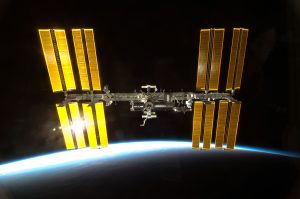So a number of years ago our lab embarked on Project MERCCURI (let’s not talk about the tortured acronym). This complex and citizen science-based collaboration (website here) has been a fascinating journey. It’s ranged from getting to watch a rocket launch in Florida, to discovering/describing a new bacterial species, to our most recent publication… the …
Our latest Project MERCCURI paper came out last week and so I figured I’d do a quick post about it here since it’s a good fit for the microbiology of the built environment. In short, we collected a number of bacterial strains from built environments on earth and sent them to the space station to …
We’ve posted previously about the results of the microbial playoffs in space (microbenet post here, and project website here). And while it’s fun to compare the growth of a microbe representing the Raiders to one representing the 49ers (Raiders won that one)… there’s a more serious question being asked here. We wanted to know what …
An important part of science is owning up to mistakes and doing the best to correct them. A couple months ago we got data from the International Space Station where we had grown up bacteria for our “Microbial Playoffs”. After analyzing the the data we blogged about the winners and disbursed the results far and …
NOTE (3-12-15): THESE RESULTS ARE INCORRECT. We have left them here for comparison. A blog post describing the problem is here and the correct information can be found here. We’ve finished analyzing all the data from the “Microbial Playoffs” part of Project MERCCURI (described here). Each microbe that was chosen to fly to the International …
Analysis of the growth data from space is ongoing but we have some preliminary results to share: Firstly, 47 of the 48 bacteria grew at least a little bit in space, the only exception was the sample collected from the Philadelphia Phillies dugout. Sorry guys! A number of the bacteria grew quite well in fact, …
After 9 months of technical delays, during which time our collection of frozen built environment microbes went around the earth every 90 minutes, we are finally getting growth data from the International Space Station (ISS)! Astronaut Terry Virts has been taking daily growth readings of our collection of 48 microbes and today (Friday) is …
For many years I have been worried about how space travel will affect microbiomes – of the space vehicles and of the residents (people, other animals, plants, etc). This is one of the reasons we started Project MERCCURI and get involved in looking at the microbes on the International Space Station. It is also why …
Well, here is another benefit of automated Google Scholar searches. I think it is unlikely I would have found these new papers without such searches but these are fascinating and directly relevant to many aspects of work we are doing on Project MERCCURI. A series of papers on microbial ecolog and space travel in the …
Just pointed to this story: Microbial stowaways to Mars identified : Nature News & Comment by Darlene Cavalier, our collaborator on the “Space Microbes” Project MERCCURI. The article reports on a presentation by Stephanie Smith at the ASM 2014 meeting going on in Boston. Smith presented results from characterizing (via culturing) the microbes present on various parts …
